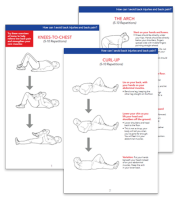How can I avoid MSK injuries?
Here are 10 things you can do to help prevent back injuries and back pain.
Stretching may lower your risk of injury and help you improve your range of motion and flexibility. Better flexibility may:
- Improve your performance in physical activities.
- Decrease your risk of injuries.
- Help your joints move through their full range of motion.
- Enable your muscles to work most effectively.
Try these easy stretches at home to help relieve low back pain and strengthen your core muscles:
Regular, low-impact aerobic activities 30 minutes a day, 5 times per week can help increase muscle strength and flexibility.
- Walking
- Swimming
- Bike riding
When you strengthen your back and abdominal muscles, they will work better together and help prevent back pain and injury — and help you look and feel better in the long run.
- Proper posture can help prevent back pain.
- When standing, don’t slouch.
- If you must stand for long periods, try placing one foot on a low footstool to help to take some of the load off your lower back.
- If you must sit for extended periods of time, choose a seat with good lower back support, armrests and a swivel base. Try placing a pillow or rolled towel in the small of your back to maintain its normal curve. Keep your knees and hips level and be sure to get up and walk around frequently.
- At home or work, make sure your work surfaces are at a comfortable height.
- Make your legs do the work and give your back a break.
- Don’t lift anything too heavy! (Ask for help when the load is too much for one person.)
- Lift from the knees, pull the stomach muscles in, and keep the head down and in line with a straight back.
- When lifting, keep objects close to the body.
- Do not twist when lifting.
If you're going to be walking or standing for any length of time, do not wear high heels but instead opt for shoes with cushioned soles.
Try sleeping on your side with your knees drawn up in a fetal position. It can help open up your spine joints and release pressure on your back. Always sleep on a firm mattress.
Here are tips for eating a balanced diet from the 2015–2020 Dietary Guidelines for Americans at a Glance:
- Follow a healthy eating pattern across the lifespan, including:
- Fruits
- Vegetables
- Protein
- Dairy
- Grains
- Oils
And limiting: - Saturated fats and trans fats
- Added sugars
- Sodium
- Focus on variety, nutrient density and amount. Choose a variety of nutrient-dense foods from each food group in recommended amounts.
- Limit calories from added sugars and saturated fats and reduce sodium intake.
- Shift to healthier food and beverage choices.
There are so many reasons to quit smoking. Here are just a few that concern your back:
- Smoking reduces blood flow to the lower spine, which can contribute to spinal disc degeneration.
- Smoking also increases the risk of osteoporosis and impedes healing.
- Coughing due to heavy smoking also may cause back pain.
There are many healthy ways of dealing with stress, including:
- Regular exercise.
- Talking with friends.
- Relaxation techniques such as yoga or meditation or massage.
